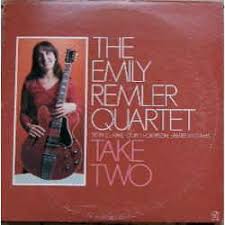
The Quarantined Jazz Voyager
As we progress further into this new year with social distancing and self~quarantine from the madness of those who feel the need to live like it’s 2019 some of us have adapted to this new normal. For those of us who no longer consider this pandemic life interrupted, we kick back and relax and listen to music.
This week I chose the second studio album by guitarist Emily Remler titled Take Two. Credited to The Emily Remler Quartet, and she was joined on the recording session by pianist James Williams, bassist Don Thompson, and drummer Terry Clarke. Williams was best known at the time for his four years with The Jazz Messengers, and Thompson and Clarke frequently worked together as part of the Jim Hall Trio.
The hard bop album was produced by Carl E. Jefferson, recorded in June 1982 at Soundmixers, New York City and released on the Concord Jazz label the same month. Leonard Feather called the album a carefully planned and brilliant executed set of performances.
Track List | 42:24
- Cannonball (Cannonball Adderley) ~ 4:48
- In Your Own Sweet Way (Dave Brubeck) ~ 4:52
- For Regulars Only (Dexter Gordon) ~ 6:43
- Search For Peace (McCoy Tyner) ~ 5:17
- Pocket Wes (Emily Remler) ~ 6:45
- Waltz For My Grandfather (Emily Remler) ~ 6:35
- Afro Blue (Mongo Santamaría) ~ 2:24
- Eleuthra (Monty Alexander) ~ 6:20
- Emily Remler – electric guitar
- James Williams – piano
- Don Thompson – bass
- Terry Clarke – drums
I’m in this for the long run and we’re going to get through this pandemic, so when the world opens back up for international travel, I’m hitting the friendly skies to once again jet setting around the globe. In the meantime, stay vigilant, wear masks and remain healthy.
More Posts: adventure,album,club,genius,guitar,jazz,museum,music,preserving,restaurant,travel
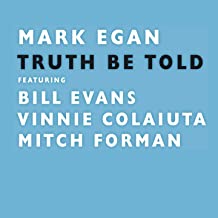
Daily Dose Of Jazz…
Mark Egan was born on January 14, 1951 in Brockton, Massachusetts and was influenced by his father, studying trumpet at age 10. Playing the trumpet throughout high school, he began playing the bass when he was fifteen. While attending the University of Miami’s Frost School of Music, initially a trumpet student, he studied with Jerry Coker. He switched from trumpet to bass part way through the program. His teachers included Jaco Pastorius, Dave Holland, and Andy LaVerne. While in Miami he became friends and performed with Ira Sullivan, Pat Metheny, Danny Gottlieb, Clifford Carter.
After graduate school, in 1975 Egan went on tour with Eumir Deodato and the Pointer Sisters and recorded with David Sanborn. Two years later, working as a studio musician in New York City, he met Joe Beck and Steve Khan. He then joined the Pat Metheny Group until 1981, before starting the jazz fusion band Elements with the Group’s drummer, Danny Gottlieb. They were joined by saxophonist Bill Evans and keyboardist Clifford Carter. They recorded and toured through the 1990s. During the 1980s and Nineties, he was a member of the Gil Evans Orchestra.
He founded his own record label, Wavetone Records and has made three music videos: Om Yoga & Meditation, Music on the Edge, and Bass Workshop. He has appeared on the soundtracks of movies including Two Moon Junction, The Object of My Affection, You’ve Got Mail, The Color of Money, Rollover, Quick Change, Blown Away, and A Chorus Line. He recorded an album, Urge, with trumpeter Forrest Buchtel, Jr., featuring, among other things, the theme from CNN Headline News.
Egan has toured and recorded with jazz artists including Stan Getz, Gil Evans, John McLaughlin, Larry Coryell, Pat Martino, Pat Metheny, Michael Franks, Jim Hall, Bill Evans, Lew Soloff, Paul Shaffer, rock and pop musicians and The Pointer Sisters, Sting, Arcadia, Roger Daltrey, Joan Osborne, Marianne Faithfull, Carly Simon, Art Garfunkel, Judy Collins, Sophie B. Hawkins, Bryan Ferry, Joe Beck, as well as Brazilians Airto Moreira, Flora Purim, and Toninho Horta.
Bassist and trumpeter Mark Egan continues to perform and record.
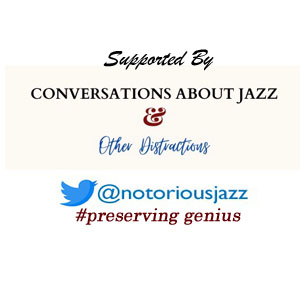
More Posts: bandleader,bass,history,instrumental,jazz,music,trumpet
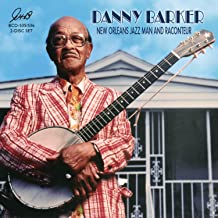
Daily Dose Of Jazz…
Daniel Moses Barker was born on January 13, 1909 in New Orleans, Louisiana to a family of musicians, the grandson of bandleader Isidore Barbarin and nephew of drummers Paul Barbarin and Louis Barbarin. He took up the clarinet and drums before switching to a ukulele that his aunt got him, and then to banjo. One of Barker’s earliest teachers in New Orleans was fellow banjoist Emanuel Sayles, with whom he would record.
Barker began his career as a musician in his youth with his streetband, the Boozan Kings, and toured Mississippi with Little Brother Montgomery. 1930 saw him moving to New York City where he switched to the guitar. Through the decade he played with Fess Williams, Billy Fowler and the White Brothers, Buddy Harris, Albert Nicholas, Lucky Millinder, and Benny Carter in 1938. During his time in New York, he frequently played with West Indian musicians, who often mistook him for one of them due to his Creole style of playing.
From 1939 to 1946 he frequently recorded with Cab Calloway, and started his own group featuring his wife Blue Lu Barker after leaving Calloway. In 1945 he recorded with pianist Sir Charles Thompson, and saxophonists Dexter Gordon and Charlie Parker. In 1947 he was back with Lucky Millinder and Bunk Johnson. He returned to working with Al Nicholas in 1948 and in 1949 rejoined efforts with his wife in a group.
During the 1950s Danny was primarily a freelance musician, but did work with his uncle Paul Barbarin from 1954 to 1955. In the mid-1950s he went to California to record again with Albert Nicholas; performed at the 1960 Newport Jazz Festival with Eubie Blake. In 1963 he was working with Cliff Jackson, and then in 1964 appeared at the World Fair leading his own group. Sometime in the early 1960s he formed a group he called Cinderella. The following year he returned to New Orleans and took up a position as assistant to the curator of the New Orleans Jazz Museum.
In 1970 he founded and led a church-sponsored brass band for young people ~ the Fairview Baptist Church Marching Band. The Fairview band launched the careers of a number of professional musicians who went on to perform in brass band and mainstream jazz contexts, including Leroy Jones, Wynton Marsalis, Branford Marsalis, Kirk Joseph, Nicholas Payton, Shannon Powell, Lucien Barbarin, Dr. Michael White and others. In later years the band became known as the Dirty Dozen Brass Band.
He played regularly at many New Orleans venues from the late 1960s through the early 1990s, in addition to touring. Beyond overcoming the obstacles of segregation, banjoist Danny Barker, who also sang and played guitar and ukulele, authored two books and was an amateur landscape artist; and who suffered from diabetes throughout most of his adult life, passed away from cancer in New Orleans on March 13, 1994 at age 85.

More Posts: bandleader,banjo,guitar,history,instrumental,jazz,music,ukulele,vocal
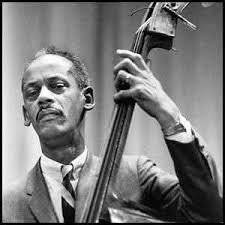
Three Wishes
Tommy Potter was pensive when of his three wishes by the Baroness but answered her questions with:
- “An adequate amount of money to carry me through and take careof my family.”
- “A healthy situation for everyone immediately concerned with me, plus an adequate amount of knowledge.”
- “That I might be able to play music that is pleasing, not only to myself but to folks that will listen.”
*Excerpt from Three Wishes: An Intimate Look at Jazz Greats ~ Compiled and Photographed by Pannonica de Koenigswarter
More Posts: baroness,bass,history,instrumental,jazz,music,pannonica,three,wishes

Daily Dose Of Jazz…
Harry Roy was born Harry Lipman on January 12, 1900 in Stamford Hill, London, England, and began to study clarinet and alto saxophone at the age of 16. He and his brother Sidney formed a band which they called the Darnswells, with Harry on saxophone and clarinet and Sidney on piano. During the 1920s they performed in several prestigious venues such as the Alhambra and the London Coliseum, under names such as the Original Lyrical Five and the Original Crichton Lyricals. They spent three years at the Café de Paris, and toured South Africa, Australia, and Germany.
By the early 1930s, Harry was fronting the band under his own name, and broadcasting from the Café Anglais and the Mayfair Hotel. In 1935 he married Elizabeth Brooke, daughter of the white Rajah of Sarawak, with whom he appeared in two musical films, Rhythm Racketeer and Everything Is Rhythm.
During World War II, he toured with his band, Harry Roy’s Tiger Ragamuffins. He was at the Embassy Club in 1942, and a little later, toured the Middle East, entertaining troops. In 1948, Roy traveled to the United States but was refused a work permit, so returning to Britain, he reformed his band and scored a hit with his recording of Leicester Square Rag.
By the early 1950s the big band era had come to an end and his band split up, sending him drifting in and out of the music scene. That decade he ran his own restaurant, the Diners’ Club until it was destroyed by fire. By 1969 Harry returned to music, led a quartet in London’s Lyric Theatre’s show Oh Clarence and his own Dixieland Jazz Band residency during the summer at Sherry’s Dixieland Showbar in Brighton, but by then he was in failing health. Clarinetist and dance band leader Harry Roy passed away in London on February 1, 1971.

More Posts: bandleader,clarinet,history,instrumental,jazz,music



